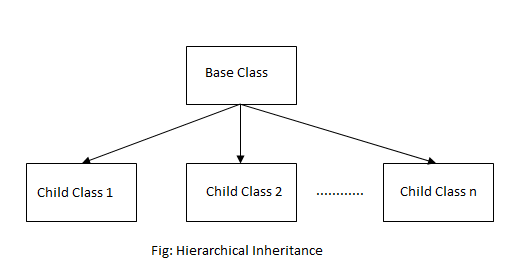Inheritance is the process of inheriting properties of objects of one class by objects of another class. The class which inherits the properties of another class is called Derived or Child or Sub class and the class whose properties are inherited is called Base or Parent or Super class. When more than one classes are derived from a single base class, such inheritance is known as Hierarchical Inheritance, where features that are common in lower level are included in parent class. Problems where hierarchy has to be maintained can be solved easily using this inheritance.
For example,
- Civil, Computer, Mechanical, Electrical are derived from Engineer.
- Natural language, Programming language are derived from Language.
Syntax of Hierarchical Inheritance
class base_classname
{
properties;
methods;
};
class derived_class1:visibility_mode base_classname
{
properties;
methods;
};
class derived_class2:visibility_mode base_classname
{
properties;
methods;
};
... ... ...
... ... ...
class derived_classN:visibility_mode base_classname
{
properties;
methods;
};

Example of Hierarchical Inheritance in C++
C++ program to create Employee and Student inheriting from Person using Hierarchical Inheritance
#include <iostream>
#include <conio.h>
using namespace std;
class person
{
char name[100],gender[10];
int age;
public:
void getdata()
{
cout<<"Name: ";
fflush(stdin); /*clears input stream*/
gets(name);
cout<<"Age: ";
cin>>age;
cout<<"Gender: ";
cin>>gender;
}
void display()
{
cout<<"Name: "<<name<<endl;
cout<<"Age: "<<age<<endl;
cout<<"Gender: "<<gender<<endl;
}
};
class student: public person
{
char institute[100], level[20];
public:
void getdata()
{
person::getdata();
cout<<"Name of College/School: ";
fflush(stdin);
gets(institute);
cout<<"Level: ";
cin>>level;
}
void display()
{
person::display();
cout<<"Name of College/School: "<<institute<<endl;
cout<<"Level: "<<level<<endl;
}
};
class employee: public person
{
char company[100];
float salary;
public:
void getdata()
{
person::getdata();
cout<<"Name of Company: ";
fflush(stdin);
gets(company);
cout<<"Salary: Rs.";
cin>>salary;
}
void display()
{
person::display();
cout<<"Name of Company: "<<company<<endl;
cout<<"Salary: Rs."<<salary<<endl;
}
};
int main()
{
student s;
employee e;
cout<<"Student"<<endl;
cout<<"Enter data"<<endl;
s.getdata();
cout<<endl<<"Displaying data"<<endl;
s.display();
cout<<endl<<"Employee"<<endl;
cout<<"Enter data"<<endl;
e.getdata();
cout<<endl<<"Displaying data"<<endl;
e.display();
getch();
return 0;
}
Output
Student Enter data Name: John Wright Age: 21 Gender: Male Name of College/School: Abc Academy Level: Bachelor Displaying data Name: John Wright Age: 21 Gender: Male Name of College/School: Abc Academy Level: Bachelor
Employee Enter data Name: Mary White Age: 24 Gender: Female Name of Company: Xyz Consultant Salary: $29000 Displaying data Name: Mary White Age: 24 Gender: Female Name of Company: Xyz Consultant Salary: $29000
In this program, student and employee classes are derived from person. Person has two public methods: getdata() and display(). These methods are inherited by both student and employee. Input is given using getdata() method and displayed using display() method. This is an example of hierarchical inheritance since two classes are derived from a single class.